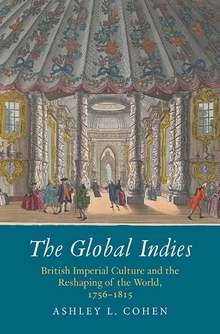The Global Indies
Ashley L. Cohen—
On a winter evening a man sits by his fireside, waiting for the serene quiet of his country retirement to be interrupted by the delivery of a London newspaper. So opens “The Winter Evening,” Book 4 of William Cowper’s long poem, The Task (1785). The set piece is, without question, mundane; but therein lay its charm. Cowper’s careful attention to the oft-overlooked minutia of daily life is what made him the most popular poet of the English middle classes. In The Task, in particular, he delighted readers by capturing a level of experience at once familiar and uncharted: the things said, thought, seen, felt, and done so often that they fade without notice into the barely registered background of everyday life. Take, for example, the occasion of waiting for a newspaper and wondering what news will be inside. When Cowper’s paper finally does arrive, his survey of the chaotic landscape of “its map of busy life” forms one of the most memorable (and most critically commented upon) passages in The Task. But the interval of waiting that precedes this survey is worth dwelling upon. For in the pause of suspension just before Cowper receives his folded-folio paper “map,” we get a mental “map” of his speculative anticipations:
. . . who can say
What are its tidings? have our troops awaked?
Or do they still, as if with opium drugg’d,
Snore to the murmurs of th’ Atlantic wave?
Is India free? and does she wear her plumed
And jeweled turban with a smile of peace,
Or do we grind her still? (4.24–30)
In the “Advertisement” that prefaces The Task, Cowper explains that he composed the poem through a process of free association, connecting one subject to another by “pursuing the train of thought to which his situation and turn of mind led him.” Whether or not we take Cowper at his word, it is significant that the “train of thought” he pursues in this passage leads straight from one side of the globe to the other. In physical space, oceans and continents separate India from North America, the battlegrounds of the American War from the conquered territories of the East India Company. But in Cowper’s mental map these regions are adjacent to one another: only the briefest of end-stopped pauses lies between them.
Cowper’s collapse of the vast distance between India and the Atlantic world captures a collective habit of mind that would have felt familiar and intuitive to his readers. They too expected to see Britain’s most distant colonies paired with one another, not only when they opened a newspaper, but also when they read a poem, or attended a play, or debated politics at a dinner party, or stopped to look at a satirical cartoon in a print-shop window. In 1785 this expectation was a commonplace one; today it is an artifact of a whole view of the world utterly remote from our own. The aim of The Global Indies is to reconstruct one way in which late Georgian Britons viewed the world, and to see what new insights this perspective might have to teach us about the literary and cultural history of British imperialism. Thinking the two Indies together will prompt us to relearn much of what we thought we already knew about key topics in eighteenth-century colonial studies, including race, slavery, class, and sociability. In the more immediate context of The Task, the two Indies will help us recover a rich theoretical vein in Cowper’s engagement with his global-imperial present.
Very often in scholarship we unintentionally gloss over the strangeness of eighteenth-century ideas about the world. This is partly due to oursense that the globe is a “transparent,” self-evident object of analysis. But, as Ayesha Ramachandran reminds us, the early modern “discovery” of a new continent across the Atlantic ushered in an epistemological crisis about the “intelligibility and scope of the known world.” Early modern “worldmakers” solved this crisis by reshaping the world: synthesizing slivers of knowledge into a new “collective unity,” a new “coherent world picture,” a new “conceptual framework.” Although the phrase does not appear in Ramachandran’s account, “the Indies” was an important organizational device in the early modern period’s new “system of order” for the globe. The age of discoveries first gave Asia and the Americas a common name: the “East and West Indies,” “the two Indies,” and, very often, simply “the Indies.” As every schoolchild knows, this shared moniker for two places that could hardly be more distant was the result of a famous mistake: Columbus’s misidentification of his so-called Caribbean discoveries as the East Indies. Yet this origin story obfuscates the more crucial point: the shared name stuck long after any misapprehension about the location of the two Indies had been rectified. Shakespeare’s Merry Wives of Windsor illuminates one reason for the pairing’s staying power: “I will be cheater to them both, and they shall be exchequers to me. They shall be my East and West Indies, and I will trade to them both.” Asia and the so-called New World were both staging grounds for European fantasies about the accumulation of riches through trade and colonization. This is why the Oxford English Dictionary gives one definition of “the Indies” as “a region or place yielding great wealth or to which profitable voyages may be made.” Fantasies of gain were load-bearing walls in the new conceptual structures fashioned by early modern Europeans to house and tame knowledge of the world. These fantasies only intensified in the ensuing centuries, as the bloody work of colonialism enabled dreams of wealth extraction to be materialized. Thus, even as the progress of geographical knowledge in the seventeenth and eighteenth centuries sundered the two Indies from one another in European cartography, they remained, in Jonathan Gill Harris’s formulation, “conceptually proximate.” Fast-forward to 1785 and they were still ever so close to one another in late Georgian mental maps of the world.
Given its early modern pedigree, the pairing of the two Indies in The Task might be deemed, in Raymond Williams’s terms, “residual.” But it would be a mistake to dismiss the Indies as a dead cultural artifact, a fossil or relic of an earlier time. Marc Bloch, a historian of medieval France, said of the remarkable survival of “the royal touch” (the idea that a king’s touch would cure scrofula): “Its longevity involves no degeneration. On the contrary, it retained a profound vitality; it continued to be endowed with a power of feeling that remained constantly active; it adapted itself to new political . . . conditions; and it assumed forms that had hitherto been unknown.” Just as the royal touch survived and thrived centuries after we would expect such magical thinking to have lost its charm, the Indies found renewed influence at a time when we might expect to see it debunked and discarded. In Britain, the peak of its potency as an explanatory framework for comprehending the world occurred in the second half of the eighteenth century.
From The Global Indies by Ashley L. Cohen. Published by Yale University Press in 2021. Reproduced with permission.
Ashley Cohen is assistant professor of English at the University of Southern California. She works at the intersection of eighteenth-century, postcolonial, and South Asia studies. Her critical edition of Lady Nugent’s East India Journal was published in 2014.
Further Reading:



























